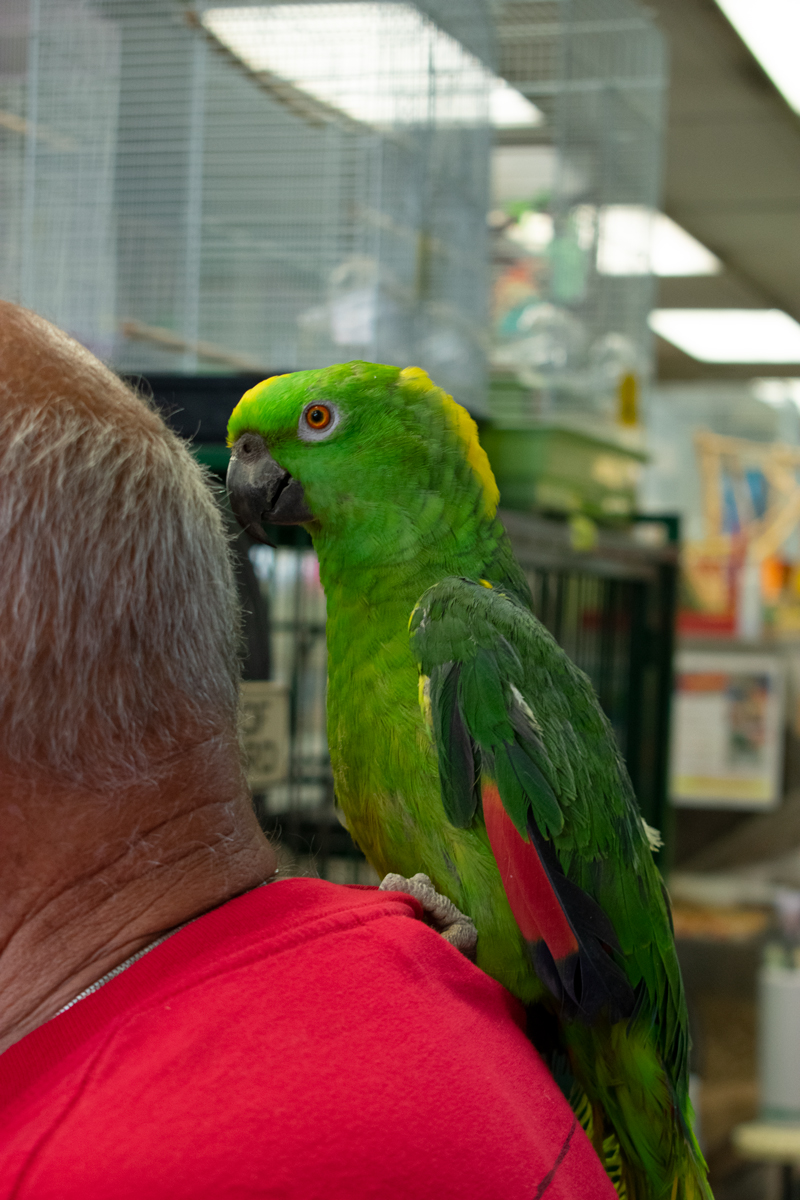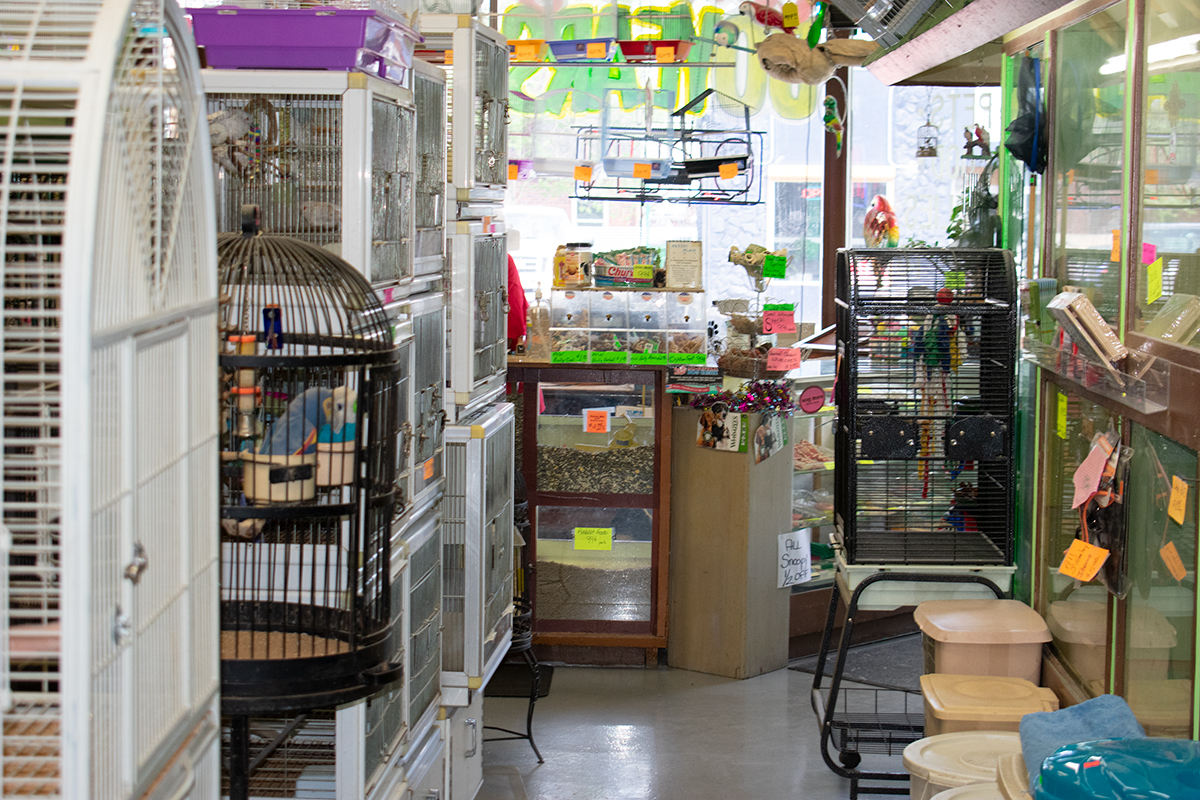
The impact of climate change
We are finding, coaching and training public media’s next generation. This #NPRNextGenRadio project is created with the University of Nevada, Reno, where five talented reporters are participating in a week-long state-of-the-art training program.
In this project, we are highlighting the experiences of people whose lives are being affected by climate change.
Colton Jimenez speaks with Marcia Sherman, a lifelong Pettin Place employee and former bird breeder. Marcia uses her experience from the pet store and her connections as a former breeder to illustrate the importance of climate change and its detrimental effects to the bird species.
Illustration by Eejoon Choi
Reno pet shop manager fears the effect of wildfires and extreme weather patterns on birds
Imagine sitting on a park bench with some bread and no birds to feed. Marcia Sherman is a lifelong animal lover and former bird breeder, and she says she’s concerned about the threat to birds and other animals due to climate change.
Sherman has been working at the pet store Pettin Place in Reno, Nevada, for nearly 50 years and is currently the store’s manager. Over the years, Sherman says the availability of some birds have decreased because of recent natural disasters like the freezing snap in Texas and wildfires in California.
“It does worry me that we’re seeing a great loss on many species of animals and birds,” Sherman said, “because there won’t be any for generations from now to see. And the beauty of these animals should be something that can be shared by all.”
Bird lover Marcia Sherman explains how the pet shop has been affected by climate change
Click here to view a transcript of the audio.
Image caption: Pet store manager Marcia Sherman at the check-out counter of Pettin Place in Reno, Nev. (Photo by Colton Jimenez)

Image caption: Pettin Place owner Linus McKibbin gives Amazon Parrot Sweet Pea some love. (Photo by Colton Jimenez)
There were instances such as the record-low temperatures in Texas in February 2021 that devastated populations of birds. Sherman shared that a bird breeder she knew in Texas experienced how the extreme weather pattern affected birds. According to Sherman, the birds were “freezing and just falling out of the trees.”
The traditional defense against extreme weather for birds is a process called fluffing up. This is when certain species stand their feathers up in an effort to preserve their warmth. Additionally, groups of birds will fly close to food to build up their energy reserves and store more fat in their body. Smaller breeds, with a lesser ability to build fat, hold a higher risk of fatality with the decreasing temperatures. Furthermore, continued low temperatures affect food supply for birds by freezing seeds and grain into the ground that are critical to their dietary needs, making the resources unattainable.
Wildfires play an essential role in the cycle of nutrients and soil regeneration in the Northern California ecosystem, but they have a detrimental effect on the life of birds. “One lady lost most of her aviaries to a fire in California, and she was actually cutting the wire of the aviaries, so the birds had a chance to get away from the fires,” Sherman said.
In 2017, California recorded a total of almost 3.1 million acres burned from wildfires. Among the ravished soil lay many homes to both families and birds. Scientists are analyzing whether large wildfires in the West contributed to the die-off of birds by increasing the toxic gases in the air and altering their migration patterns.
Migrating birds are going to need help as there are many external weather events that endanger birds during their migration, and having safe spaces to rest along the way can help them survive. To help preserve their lives, backyard sanctuaries for birds that include feeders and fountains could be the forefront to fighting back against climate change.
Customers of the pet shop Sherman manages are increasingly unable to obtain certain species of birds. “We no longer see the gray cheek pocket parrot,” Sherman said. Several other birds are harder to source as well, and she says that’s unfortunate because birds make such wonderful companions.
“People bond very well with their pets. And it’s a lifestyle for them. I mean, I know people that cook special diets for their birds at home with special treats. I know some people that have redesigned their house just to have a big aviary room for the birds where they basically have a tree and a big room of their own, not even in a cage,” Sherman said.

Image caption: A once fully-stocked store now operates with just the essentials due to the decreasing access to exotic birds. (Photo by Colton Jimenez)
Climate change in Northern America threatens more than 300 species alone. For someone who loves animals and also helps to supply birds to people in the community, Sherman is concerned. “There’s thousands of species of birds. So many of them we will just never ever see again,” Sherman said.
Video caption: Marcia Sherman reflects on how wildfires have impacted Pettin Place and breeders. (Video by Colton Jimenez)
Transcript
(SOUNDBITE OF A DOOR OPENING INTO A SPACE WITH CHATTER AND BIRDS CHIRPING)
MARCIA SHERMAN: Gosh, when I was a little kid, my, my main thing was I was always hanging out within the barn with the horses and the cats and the dogs. And my grandmother was constantly telling my mother to get me away from the animals because I was never gonna find a man. (Laughs)
Birds can be one-person animals, and they bond with the one person. You want to say hi, Barkley?
My name is Marcia Sherman, and I’m the manager of Pettin Place in Reno, Nevada. I’ve worked here for 48 years, caring and cleaning and feeding and playing with the animals, as well as trying to teach people about the pet they’re about to buy.
My earliest exposure with birds were barn swallows that used to swoop down at us for getting too close to their nests in the barn. And then, by accident, I started to help a lady that was hand-feeding baby birds, and then she retired, and we took over a lot of her flock and started doing the breeding, as well as the hand feeding of the baby birds.
I’m just fascinated by them. Their personalities; their colors. They can tear you open if they so desire, if they’re upset with you enough, or they can be as sweet as a baby.
(SOUNDBITE OF SWEET PEA, AN AMAZON PARROT)
SHERMAN: I don’t think a lot of people fully understand that the animals, the people, the birds, everything will be affected by climate change.
Friends that have, you know, large aviaries and outdoor breeding facilities have affected myself and the business due to the drought and the fires and the extreme temperatures.
One lady lost most of her aviaries to a fire in California, and she was actually cutting the wire of the aviaries open, so the birds had a chance to fly, to get away from the fires.
A gentleman in Texas that I know, his birds were freezing to death and just falling out of the trees because, in that part of Texas, they weren’t used to the extreme cold temperatures.
The sad part is not only losing the birds, but we’re also… the drought and everything is losing some of the supplies for their food chain as well.
The joy of owning a bird is the companionship. And it’s a lifestyle for them. I know people that cook special diets for their birds at home, special treats. I know some people that have redesigned their house just to have a big aviary room for the birds where they basically have a tree and a big room of their own, not even in a cage.
They each had their own personalities and their own joy that they brought me.
Probably the greatest one was a green wing Macon named Captain that the owner of the shop here and I actually co-owned. She thought she was my baby (laughs), and she was just, you know, she would greet you every morning. She would lay on her back and in my arms, and I could cradle her like a baby. She just talked to you and played, and you could teach her tricks.
I love what I do just because I love being able to care for the animals; you have to be able to do the work so that they live long happy lives.
It does worry me that we’re seeing a great loss of many species of animals and birds because there won’t be any for generations from now to see. And the beauty of these animals should be something that can be shared by all.
ACKNOWLEDGEMENTS:
The Next Generation Radio Project is a week-long digital journalism training project designed to give competitively selected participants, who are interested in radio and journalism, the skills and opportunity to report and produce their own multimedia story. Those chosen for the project are paired with a professional journalist who serves as their mentor.
This #NPRNextGenRadio project was funded by The Reynolds School of Journalism at the University of Nevada, Reno.
Our staff:
- Managing Editor – Traci Tong, Freelance Editor, Boston, MA
- Digital Editors – Amara Aguilar, University of Southern California, Los Angeles, CA, Laura Gonzalez, University of Southern California, Los Angeles, CA; and Crystal Willis, KUNR Public Radio, Reno, NV
- Audio Tech/Engineers – Selena Seay-Reynolds, Next Gen Radio Lead Audio Engineer, Los Angeles, CA; and Yuki Liang, Los Angeles, CA
- Illustrators – Eejoon Choi, Northridge, CA; Lauren Ibanez, Houston, TX; and Ard Su, New York, NY
- Visuals – Michelle Baker, Freelance Visual Journalist, Reno, NV
- Web Developer – Robert Boos, Web Developer/Editor, Minneapolis, MN
Our journalist/mentors for this project were:
- Anh Gray, Audio Coach, The GroundTruth Project, home to Report for America, Reno, NV
- Tim Lenard, Visual Journalist, The Nevada Independent, Reno, NV
- Jazmin Orozco-Rodriguez, Reporter, Kaiser Health News, Elko, NV
- Regina Revazova, Founder, Open Conversation, Phoenix, AZ
- Natalie Van Hoozer, Bilingual Reporter, KUNR Public Radio, Reno, NV
The Next Generation Radio program is directed by its founder, Doug Mitchell, NPR, Washington DC.

